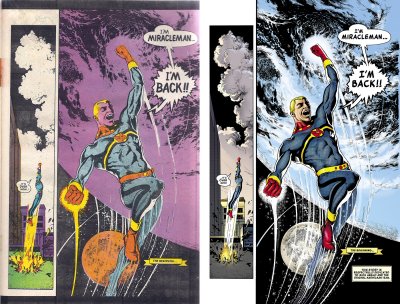Our fearsome crew of comics reivers increases this week: please welcome the new guy, Cat Taylor, as he tackles one of the most significant reissues in recent comics memory. But first, the irrepressible Adam X Smith lays the groundwork:
Young and Old and Gone…: My Take on Miracleman #1 (Marvel, $5.99)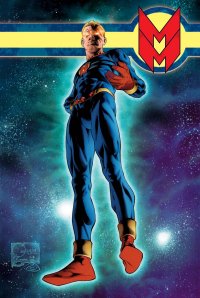
By Adam X. Smith
As the first of two writers tackling Marvel’s first issue of Miracleman, I’m gonna keep it to a few brief bullet points, as well as some (hopefully) interesting factoids for the uninitiated about the long and winding road that has led us to this, the return to print of one of the precursor books of the Eighties Renaissance in Comic Books.
Originally known as “Marvelman”, Miracleman was created in 1954 by late writer-artist Mick Anglo as a replacement for the recently discontinued Captain Marvel by Fawcett Comics. Due to the popularity of black and white reissues of Captain Marvel in Britain, its publisher Len Miller drafted Anglo to create the Marvelman character as an expy of Captain Marvel and the series remained popular well into the Sixties before it finished its run in 1963.
Then, in 1982, the character was reimagined by Alan Moore (credited in the Marvel reprint as “The Original Writer”) and Garry Leach for Warrior. As it turns out, though, this was technically in violation of not just Marvel Comics’ veto on anyone but them being able to use the name “Marvel” in comics – Dez Skinn, the editor of Warrior, had not purchased the rights to the character as he had previously claimed he had, assuming no-one would care about it. And that’s not all…
As part of his Big Picture video blog series at The Escapist, Bob “MovieBob” Chipman neatly summarises the protracted legal history surrounding the creation, stagnation and rebirth of Miracleman here and here. He also predicted the return of Miracleman as early as April last year, back when Neil Gaiman-created Spawn character Angela was revealed to be jumping ship to Marvel in what was then a big enough WTF news story on its own.
Despite going uncredited – apparently at his own request given his track record – Moore has gone on record saying he believes any royalties generated by reprints of his tenure on the book should go to Anglo’s estate. Also, the remastered first issue concludes with a dedication to him and the original Marvelman team (see comparison image below).
Moore’s signature book design style remains intact, with the issue replicating Eclipse Comics’ Miracleman #1, including a reprint of an old Mick Anglo/Don Lawrence story from 1956 about time-travelling Science Gestapo agents from 1981 – it was the Fifties, after all. Nooj. The final page, which acts as one of Moore’s patented zoom-in transitions, features a quote from Nietzsche’s ‘Thus Spake Zarathustra’ (“Behold, I teach you the Superman: He is this lightning, he is this madness!”), paving the way for the kind of heavy philosophical subtext that would dominate his later work on Watchmen and V for Vendetta and also providing a cheap title page quote for Grant Morrison to borrow/reference/steal/run into the ground in his self-congratulatory and overlong Supergods: Our World in The Age of the Superhero.
One of the villains in the flashback scene to Miracleman’s origin is called Young Nastyman, arch-rival and nemesis of the Miracleman Family with powers comparable to Miracleman. “What powers?” you ask. I dunno – how about the power of flight? That do anything for ya? That’s levitation, holmes. Sorry, couldn’t resist.
And finally, Miracleman’s magic word “Kitoma!” is the word atomic said backwards. Thought we wouldn’t notice, but we did.
Trivia is all well and good, but is the story itself worth it? Well, in this writer’s opinion, it is, not just in and of itself, but for what it represents as a precursor to Moore’s later and greater career, as a revamped comic that doesn’t feel like it’s been robbed of its original charm, and because after so long out of print the book never feels dated. Seeing the cleaned up, recoloured work thirty years on is like discovering the beauty of “A Quick One While He’s Away” by The Who after thinking that Tommy or Quadrophenia was the be-all-and-end-all. This was Moore’s Revolver, his True Romance, and making it available for the young and old alike to rediscover, as the series has long been out of print following Eclipse Comics’ dissolution in the early nineties, and back issues and collections from that era remain very rare and extremely expensive to track down.
Maybe it’s because I’m a sucker for Alan Moore, maybe it’s the retro-appeal of the classic Brit-comics of the Eighties, and maybe it’s the promise of further electricity, deconstruction of the medium and gritty violence to come. But in this case, I’m on board.
All of this to say, Miracleman #1 is well worth the wait. Do yourself a favour. Buy this comic.
Rating: 




Out of a Possible 5 Stars
Miracleman #1 (Marvel $5.99, seriously)
By Cat Taylor
For all the cringeworthy images that the 1980s bring to mind, it was a great time to be a comic book fan. Being an  active reader and older teenager at the time, I was able to experience first-hand the most exciting innovations that had occurred with the medium since the launch of Marvel comics approximately 20 years earlier. One of the leaders of comic book storytelling innovations in the 1980s was, of course, Alan Moore. The success of his Watchmen resulted in the republishing of Moore’s earlier undiscovered work such as V for Vendetta and of course, Miracleman. What Miracleman revealed at the time was that Moore had brought the idea of the deeply flawed and violent Nietzchian superhero, and more mature themes to the comic book medium years before he wrote Watchmen.
active reader and older teenager at the time, I was able to experience first-hand the most exciting innovations that had occurred with the medium since the launch of Marvel comics approximately 20 years earlier. One of the leaders of comic book storytelling innovations in the 1980s was, of course, Alan Moore. The success of his Watchmen resulted in the republishing of Moore’s earlier undiscovered work such as V for Vendetta and of course, Miracleman. What Miracleman revealed at the time was that Moore had brought the idea of the deeply flawed and violent Nietzchian superhero, and more mature themes to the comic book medium years before he wrote Watchmen.
The stories of the legal situations that have kept the old Miracleman books from being republished or any resurrection of the character are complicated and have been well-documented elsewhere but suffice to say, all of that has been worked out. Now, despite curmudgeonly grumbling from “the original writer,” Marvel comics is republishing the original run with extra material. Although it’s the younger readers who are getting the most benefit out of the republished series (well, okay, the publisher is getting the MOST benefit) because many of them are getting to read it for the first time, older readers such as myself are getting to re-experience what were only vague memories until now.
While I don’t want to spend a lot of time recapping the story, I do want to point out some highlights. Structurally, the story starts with a pretty typical 1950s “Marvelman” type of story to give the reader some background to the character’s history before shifting to 1981, the present day for Miracleman, and a stark contrast in story tone and art to the “Miracleman” world of the 1950s. Conversations between Miracleman’s alter-ego, Michael Moran, and his wife further highlight the difference as his wife represents the modern (early 1980s) reader’s viewpoint of how ridiculous the old comic book stories were. Moran, on the other hand explains, “It’s my life. It made perfect sense in 1956.”
Another theme I recalled when re-reading this story today was just how terrified people were of nuclear power in 1980s. People know nuclear power is potentially dangerous now but you don’t hear a lot about it and it isn’t a common literary theme anymore. However, the danger and fear of nuclear power is one of the central themes in this story, as it was in many comics, books, and movies of the 1980s. I suppose society in general has accepted the existence of nuclear power and, like the “grim and gritty” superhero, they have become desensitized to it as an ever-present danger with a hair trigger. It’s a pretty odd thing to be complacent about when you think about it objectively. Yet, in that way, our real world is strangely similar to the fictional comic book universe of Marvel or DC; enough power out there to destroy the world several times over that’s only kept in check by human personalities and others with similar power. This is just one of the many concepts that Moore explored with Miracleman and later, Watchmen.
When I read the original Miracleman series in the 1980s, I had the advantage of borrowing several early issues from someone else’s collection. So, I was able to get more of the story in a single setting. Re-reading the first issue all by itself now, I wonder if it would have enticed me to stay on board for the next issue, especially at a $5.99 price tag (even though this issue is padded with a lot of extra material in an attempt to justify the price). I also have to consider how many rip-offs and bastardizations of Alan Moore’s early concepts have saturated the market since Miracleman was originally published. I suspect that many younger readers are so desensitized to Moore’s themes that many who picked up this first issue based on reputation will abandon the series because they won’t understand what’s so great about it. That’s really a shame too because just like with any other form of art or entertainment, the modern versions may be flashier but the originals have a heart and innovative quality that can never be duplicated and are more deserving of respect and admiration. I just hope that most people who haven’t read Miracleman before won’t give up after this first issue, because patience will pay off. I can say that with authority, because like Michael Moran in this issue, “I remember now.”
Rating: 




Out of a Possible 5 Stars
New Year, New 52 (Sort of a review of Green Arrow, Action Comics, Batman/Superman, DC $3.99 each)
by D.S. Randlett (@dsrandlett)
 So New Year’s has come and gone. I don’t know what you did for New Year’s Eve, but if you were, say, an analog of DC Comics at and industry party you were probably standing in the corner, wondering why no one has complimented you on that new haircut that you think makes you look younger. Sure, people have said some nice things about that one shirt, or that one tie, but you’re still stuck. You’ve committed, and there’s no going back, but something just isn’t working. As the ball drops, what do you do? Do you think about going back? Or do you look for the next thing?
So New Year’s has come and gone. I don’t know what you did for New Year’s Eve, but if you were, say, an analog of DC Comics at and industry party you were probably standing in the corner, wondering why no one has complimented you on that new haircut that you think makes you look younger. Sure, people have said some nice things about that one shirt, or that one tie, but you’re still stuck. You’ve committed, and there’s no going back, but something just isn’t working. As the ball drops, what do you do? Do you think about going back? Or do you look for the next thing?
The treatment of Superman’s 75th year said a lot about the state of DC Comics. Man of Steel (which I mostly liked, for the record), the Superman celebration hardcover, and the bungling of their flagship title’s creative team (Remember when Andy Diggle was the new Action writer?) all pointed to DC wanting to take Superman inward and to a somewhat more “broody loner” place in an effort to make him, and everything else in their company that doesn’t revolve around Batman “more relevant.” Grant Morrison had the right idea two years ago. Want to make Superman relevant? Get back to first principles. After all, Superman was born in a time of decline, a time when things in the U.S. were really rough for massive amounts of people, and he was a phenomenon for one simple reason: He encapsulated the desire to stand up to everything wrong with the world at the time and basically say, “Fuck. That.” But not in a selfish or brooding way. From the original Action Comics #1, the character was about bravely facing the problems of the world and finding ways to fix them.
Back to that in a second. First, it’s time to look at one of the things that DC got right, a title that entered a really cool and fun new phase with the final issue of 2013: Lemire and Sorrentino’s Green Arrow. I’ve gone on record around here about my love for this series. It’s just plain good, but it also encapsulates the opportunities of DC’s New 52 thing. Lemire’s Oliver Queen isn’t the seasoned, quippy crusader of the former DCU, but still a hero learning the ropes. He’s traced a really great arc for the character so far, casting him as a privileged adrenaline junkie who has everything stripped away from him again after his time on that infamous island, which the current arc has sent him back to. Lemire mines inspirations like Denny O’Neill’s The Question and the Bendis run on Daredevil to come up with a psychadelic examination of heroism starring a character who already thought that he was a hero.
Sorrentino’s art is also consistently great, as is his storytelling. One of the problems with Green Arrow as a character is that his ranged specialty is hard to make viscerally exciting. Sorrentino has found a lot of really fun ways around this, though, making great use of color and all around psychadelic vibe of the story. Arrows, and weaponry in general with the introduction of these new Weapon Clans, become messengers of intent as well as tools for fighting.
What they do on the final page of their most recent issue is pretty ballsy (I’m not spoiling it, don’t worry), in that it’s a direct call out to the character’s past publishing history, using a certain visual cue to reframe their run in terms of prior Green Arrow runs in a way that works specifically for the story that their telling, and in turn provide a template for what can work in the New 52 in terms of DC’s “legacy” identity by refitting older iconography into the current series in a coherent way.
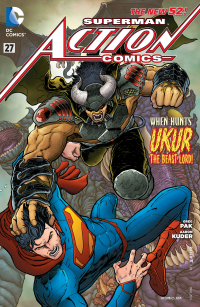 But back to DC’s flagship character, Superman. When they hired Greg Pak to work on Batman/Superman and Action Comics, there was a feeling in the air that that was a desperate move: hire a “name” writer in an attempt to beef up flagging sales after the company had seriously bungled managing the creators and direction of the series and character, and last year’s drama surrounding the Superman line seemed to be pretty emblematic of how DC was running its entire line of comics, resulting in falling sales and, in general, pretty poor story quality. So it was hard to tell if the presence of Pak would turn the line around, or if he’d be gone after two issues.
But back to DC’s flagship character, Superman. When they hired Greg Pak to work on Batman/Superman and Action Comics, there was a feeling in the air that that was a desperate move: hire a “name” writer in an attempt to beef up flagging sales after the company had seriously bungled managing the creators and direction of the series and character, and last year’s drama surrounding the Superman line seemed to be pretty emblematic of how DC was running its entire line of comics, resulting in falling sales and, in general, pretty poor story quality. So it was hard to tell if the presence of Pak would turn the line around, or if he’d be gone after two issues.
Action ended up being the real surprise of the last few months of 2013. I expected Pak’s run to be at least adequate, as that guy is a consummate professional, but Pak brought a real vision to action in terms of theme and character, and artist Aaron Kuder has been turning in absolutely brilliant work. Their Superman feels like, well, Superman, but in a different place in his life than we usually see him in. He’s younger, a little more brash, and doesn’t yet know what he’s really capable of. But Pak has shown that he really gets the core of the character, and I think that he also understands that to make Superman relevant you don’t need to drag the character into a grim and brooding morass, but make his challenges reflect the challenges that face the current generations of living people and allow his response to that to be what it always is, or at least should be: compassionate and morally brave.
In Action we have Superman and (an awesome version of) Lana Lang discovering a subterranean nation of monsters. In the most recent arc of Batman/Superman, we had Mongul using a scifi MacGuffin of a video game to unleash the aggression of the Earth. In both of these stories, Pak’s scripts take aim at what it seems like the current regime thinks Superman should be, or what should happen to him. In Action, Superman subverts the expectations brought on by Man of Steel’s ending. Instead of outright killing a giant monster, he lets everyone think that he did when he really stuck it in the Fortress of Solitude’s zoo, where he finds that there’s more to this creature than meets the eye. Pak and Kuder cleverly leverage Superman’s own upbringing into a story about being willing to see the real person beneath the surface.
Batman/Superman (a title that admittedly hasn’t quite found its voice yet) also has its own expectations to 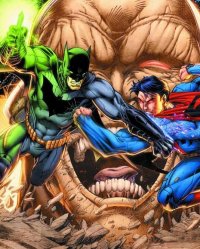 subvert, this time with regard to a fight between Superman and Batman, where Batman ends up being powered up by Mongul’s nanobots and possessed by the aggressive wants of millions of gamers. Here, Pak takes aim at the indulgent nature of our media. To find a resolution, Superman has to find a way past those loud surface emotions and communicate a set of higher ideals. There’s been a splash page from of a powered up Batman punching Superman’s lights out making the rounds on the internet feeding the “Superman is a pussy!” meme, but in context that moment plays like a moment of triumph for Superman. It’s the moment when he displays a sense of self sacrifice to liberate Batman from the shallower emotions that hold him.
subvert, this time with regard to a fight between Superman and Batman, where Batman ends up being powered up by Mongul’s nanobots and possessed by the aggressive wants of millions of gamers. Here, Pak takes aim at the indulgent nature of our media. To find a resolution, Superman has to find a way past those loud surface emotions and communicate a set of higher ideals. There’s been a splash page from of a powered up Batman punching Superman’s lights out making the rounds on the internet feeding the “Superman is a pussy!” meme, but in context that moment plays like a moment of triumph for Superman. It’s the moment when he displays a sense of self sacrifice to liberate Batman from the shallower emotions that hold him.
So it’s a new year. Last year you lost some weight and got a new look. You received some compliments, but something is missing. In DC’s case, a lot of it was attitude and outlook. DC is probably looking at these titles and taking some notes. Hopefully the publisher gets the right message.
Green Arrow Rating: 




Out of a Possible 5 Stars
Action Comics Rating: Out of a Possible 5 Stars




Batman/Superman Rating: 




Out of a Possible 5 Stars
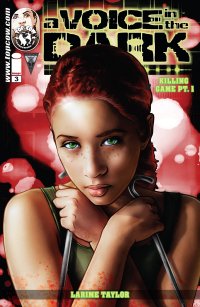 A Voice In The Dark #3 (Image/Top Cow, $3.99)
A Voice In The Dark #3 (Image/Top Cow, $3.99)
By Jeb D.
Last fall, I reviewed the very promising debut of an unconventional horror comic: A Voice In The Dark features an unusual cast of realistically (if simply) rendered characters, largely women of color; it’s a black-and-white comic that makes effective use of grayscale; and it’s unsettling in ways that are quite different from what a Steve Niles or Joe Hill brings to comic-book horror. Issue #2, which hit over the holidays, was the most profoundly disturbing comic I’ve read in quite some time.
The first two issues of the series functioned as an introductory piece, and with issue #3, it would appear that we’re off into the story proper: Zoe’s the college freshman hosting a call-in radio show, hoping that its nighttime anonymity will help to control the impulses that led to the fact that she has already gotten away with one murder, that she can’t completely bring herself to regret having done so, and that she’s by no means certain it’ll be her last. In this issue, we see Zoe dealing with the fallout from the tragic (or was it?) conclusion of issue #2, as she also begins to get the first intimations that it may not be entirely coincidental that a young woman with murderous impulses is attending this particular institution of higher learning.
I won’t say more about the plot; you could pick up the story here, but I’d suggest seeking issues #1 and 2 first if you can (the first trade collection is planned to include issues #1-7, so it’ll be a while before we see it).
For all the stark simplicity of the backgrounds and deisgn, writer-artist Lamire Taylor has a great eye for the unconscious gestures and fidgets we exhibit in times of stress: characters polish glasses, chew lips, peek uncertainly around doors; his work is never photo-realistic, but instantly recognizable and relatable.
The striking art, macabre storyline, and decidedly non-traditional cast would be strong recommendations for the book, but the character of Zoe really holds it all together. More than once, she reminded me of one of Gillian Flynn’s damaged female protagonist/narrators (not so much Amy Dunne from Gone Girl, but the more overtly disturbed Libby Day from Dark Places or Camille Preaker from Sharp Objects): she has the same ability to be both resigned to, and horrified by, the person she sees in the mirror, and a dry wit to go along with it (during a meeting with the manager of the college station, after receiving some unexpectedly good news, Zoe muses “I’m feeling real bad about fantasy-strangling her now“).
I can’t stress enough how completely different this comic is from just about anything you’re currently reading; I suppose its closest cousin would be Rachel Rising, another black and white horror comic with a mostly female cast, but Taylor’s comic has, you should pardon the expression, a “voice” very much its own.
Rating: 




Out of a Possible 5 Stars
Astro City #8 (DC/Vertigo $3.99)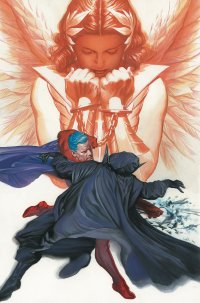
By Cat Taylor
Whenever someone tells me they’ve stopped reading superhero comic books because they’re bored of the same old thing, I immediately recommend Astro City. Kurt Busiek, the creator and writer, has a superpower of his own and that power is the ability to never run out of innovative ideas and approaches to the superhero genre that have somehow managed to elude every other comic book writer who has ever lived.
Issue #8 is the second part of a story arc focusing on Winged Victory, a female hero with the specific mission of helping women. Unlike mainstream comic book heroes, this Wonder Woman-esque archetype doesn’t just fight criminals. She has established women’s rehabilitation centers across the nation for abused and otherwise troubled women to train them in self-defense, provide life assistance, and otherwise empower them to turn their lives around and get back on their feet.
In retrospect, it seems obvious that at least a few comic book superheroes would be helping out the needy with resources other than their fists and power beams. However, I can’t think of a single superhero character that does anything like this as part of his or her primary mission. I’m sure Bruce Wayne and Tony Stark have used their wealth to establish charities, but how often do you really see anything about that in their stories?
The mystery villain of this story is attempting to bring Winged Victory down by discrediting her and bringing general doubt about her validity as a hero by planting false evidence and having several of her arch-enemies claim that they’ve been secretly working with Winged Victory for years and all of their fights and crimes have been staged. As we learned last issue, this kind of attack could potentially do more than just make Winged Victory into a misunderstood vigilante like Spider-Man, because the level of her super-powers is dependent on the growing empowerment of females across the world. The Council of Nike, who gave superpowers to her, could conceivably also take them from her if she can no longer be a credible symbol of true female empowerment, truth, justice, etc. Bringing unique yet retrospectively obvious touches like this are examples of the flavor that Kurt Busiek brings to the world of Astro City.
In addition to the main plot, there are a number of less obvious underlying touches and subplots taking place this issue including some symbolic literary commentary on the stereotype perpetuated in mainstream comics where the female comic book hero is portrayed as secondary, even subservient, to the superior male heroes no matter how powerful the female character is supposed to be. If you aren’t into dissecting women’s studies in comic book literature, you can still enjoy a nice Busiek take on the Superman/Batman/Wonder Woman dynamic played out by their Astro City counterparts, Samaritan/Confessor/Winged Victory. In other words, Astro City has a little something for everybody.
Although the star of any Astro City book is Kurt Busiek’s writing, Brent Eric Anderson and Alex Sinclair deserve considerable credit for their art. The art reminds me a lot of Neal Adams’ intricately detailed work but with softer edges that somehow manages to be a perfect fit for Busiek’s stories.
As with any other Astro City story, I’m fully engaged in this story and I’m anxious to see where it’s going in the next issue. I have a few suspicions but whether I’m correct or not, I know I can count on Kurt Busiek to make it interesting. These books pack in a lot of story, both in quantity and quality. If you’re going to pay $3.99 for a comic book, there’s no better value than Astro City.
Rating: 




Out of a Possible 5 Stars
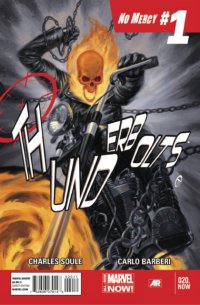 Thunderbolts #20 (Marvel, $2.99)
Thunderbolts #20 (Marvel, $2.99)
By Adam X. Smith
You know, it’s not really doing much for my credibility that I’m reviewing an All-New Marvel Now! title two weeks in a row – and one that’s not even a new title, no less – after complaining about DC doing the exact same thing with their Zero/Villains Months in my End of Year review. The difference, if there is any, is that Marvel’s stated goal with the Now! campaigns seems to be to give new readers a relatively clean jumping-on point for new books and long-running series with complicated backstories, whereas in DC’s case it’s just a license to retread characters’ origin stories every bloody year – for fuck’s sake, Batman alone has been given an entire year of having his origin fiddled, tinkered and otherwise interfered with on the basis of it being an easy sell. And if I were a little younger and little less jaded it might still work.
So believe me when I tell you that the reason I picked up Thunderbolts #20 (no, I will not be tacking the stupid “.Now” suffix on, I’ve not completely taken leave of my anarchist principles) was because I did want to test the theory and find out whether this was in fact as good a place as any to jump back on a series that I have been going through a cycle of discovering, dropping and then picking up again as far back as Warren Ellis’ run on it back in the hazy days of the all-consuming Civil War crossovers. When Ellis took over the book, the Thunderbolts were a semi-defunct team from the Nineties which had been one-note when it was new*, and like so many other comics, he gave it a layer of fresh intrigue – under him the team were now Marvel’s answer to the Suicide Squad, a group of ex-supervillains led by a “reformed” Norman Osborn, given time off their life sentences by Uncle Sam in exchange for rounding up unsanctioned heroes during the Pro/Anti-Registration gimmick. In fact, it’s the love I have for Ellis’ run on the book that keeps me bothering with the title at all, in the vain hope that it might reach those heights again.
So what does the current run have to do with all that? Sadly, not a lot. The Suicide Squad angle remains – black-ops, shady government dealings – but rather than the perverse appeal of confirmed supervillains like the Osborn, Moonstone, the Mac Gargan-era Venom and Bullseye being incredible arseholes, we now essentially have a bunch of superhero assassins, led by Red Hulk aka General “Thunderbolt” Ross (see what they did there?).
But with the Secret Avengers already being positioned neatly in the black-ops superheroes slot, Thunderbolts’ way of differentiating itself is by having the roster filled with “hardcore/badass” characters – Punisher, Elektra, a paraplegic Flash Thompson using the Venom symbiote as combination prosthetic/body armour (yeah, I’m not convinced by that either), a repowered Samuel Sterns aka The Leader and Deadpool – because it’s not like I don’t read enough Deadpool comics already.** Basically, it’s the Avengers for the heroes who are too ethically dubious to be trusted by even SHIELD, if such a thing is possible. And they all have red and black costumes because brand synergy.
So does #20 serve as a decent jumping on point? Yes and no. The inner art by Carlo Barberi is a massive improvement, which given that, during the Marvel Now! relaunch, it was drawn by Steve “Preacher” Dillon is a sad state of affairs – Dillon’s work on the book was not reflective of the standard I’ve so far associated him with. Plotwise, it’s about the same – Charles Soule isn’t bad, but neither is it much more than what Daniel Way had to offer. In the opening recap, it explains that in exchange for completing missions for Ross the heroes get favours of their own dealt with in a sort of quid-pro-quo arrangement, although if this was ever part of the book when I read it before I can’t tell you – either I simply forgot or it’s something that the writers failed to make adequately clear or I’ve simply missed too many issues to have picked up on it.
Regardless, it’s not that far off where I was up to before – Ross and co are trying to capture or kill a supervillain called Mercy. Their way of doing that? Get Ghost Rider to show up and summon her to Hell. Umm… what? Why? They even hang a lampshade on the fact that they’re going with Ghost Rider over someone more qualified, for what it’s worth, but it’s really no more than an excuse to have a big splashy image of Ghost Rider on the cover (Thunderbolt’s primary appeal seems to be the cover art) and cram yet another extreme guest spot into a book that doesn’t really have anything actually… you know, happening in it. Perhaps if it bothered to be more of a back-door pilot for a standalone Ghost Rider book it wouldn’t feel so galling.
I mean, don’t get me wrong, it’s not bad – I just don’t know if it’s enough to woo me back. What the book has inched back in terms of art it’s not really gained in terms of bringing something interesting to the story table. Still, for what is essentially an excuse to put Ghost Rider and a big fat “#1” graphic on the cover it’s not terrible, if not a recommended read.
*Potted history time – the Thunderbolts where a group of superheroes who showed up when the Avengers where mysteriously disappeared for a while, and in a twist later turned out to be perennial arsewipes the Masters of Evil in disguise. Because in the Nineties that counted as a twist.
**I chose this over two Deadpool specials specifically in order to lower my weekly intake of the Merc with the Mouth and balance it with other stuff for a change. There is such a thing as too much Deadpool, guys, and I’ve seen it.
Rating: 




Out of a Possible 5 Stars
